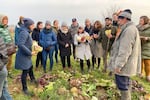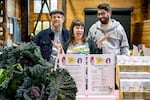
Mary Colombo walks along her four-acre farm in Troutdale, Ore., on Jan. 25, 2023. Wild Roots grows more than 25 different radicchio varieties which they harvest from September all the way through February and March.
Crystal Ligori / OPB
On an overcast winter morning, the four acres of Wild Roots Farm look pretty dormant to the untrained eye. A string of winter storms and some 20-degree nights have left what looks like rows of muddy soil with spots of wilting vegetation mixed in. But Mary Colombo sees things a little differently.
“On the outside it’s all slimy and dead,” said Colombo, “but peel back all those layers and inside is this beautiful green head of radicchio with [what] looks like elf-painted pink speckles all throughout.”
Colombo is describing a Variegato di Chioggia, one of the more than 25 varieties of radicchio she and husband Brian Shipman are growing on their farm in Troutdale, Oregon. A significant portion of their crop plan — about a half acre — is planted out in fall/winter radicchio.
“We start harvesting radicchio in September and you sort of have a continued harvest sometimes up [until] March if we’re lucky enough,” she said.
That extended radicchio growing season helps to combat something known to farmers as the “hunger gap” — that time between late November and early March when there just isn’t a lot of local produce growing. In the winter, consumers are often craving something bright and leafy, while many farmers are just looking to stay afloat.
“Being able to have a crop like this that is going to help your farm continue having income and being able to pay the bills and labor,” said Colombo, “is just a huge benefit.”
Colombo and Shipman were first introduced to radicchio while working for a farm in California. After moving back to the Pacific Northwest and starting Wild Roots, they knew they wanted to grow radicchio, but finding high quality seed was an issue.

A cross section of a Variegato di Chioggia harvested from Wild Roots Farm in Troutdale, Ore., on Jan. 25, 2023.
Crystal Ligori / OPB
“There wasn’t a lot of good seed access in the United States [since] most of the seed is produced in Italy,” Colombo said. “It wasn’t until the last like five or six years with Lane from Culinary Breeding Network and other Italian Americans cultivating relationships with seed producers in Italy [that we] have access to much better seed.”
That’s Lane Selman, a professor of practice at Oregon State University and founder of the Culinary Breeding Network, who is a bit of a matchmaker between farmers, chefs, plant breeders and consumers in the Pacific Northwest.
A little more than a decade ago, Selman was part of a collaboration with Oregon State University called the Northern Organic Vegetable Improvement Collaborative (NOVIC), where researchers, farmers and educators worked to select different vegetable varieties that would grow well on organic farms. She was working closely with plant breeders, who she referred to as the “wizards behind the curtain.”
“Nobody knows about them,” Selman said, “But they’re actually making a lot of important decisions that impact what we eat and what farmers have to grow.”

Mary Colombo holds a Variegato di Chioggia on her farm in Troutdale, Oregon. on January 25th. 2023. They grow more than 25 varieties of radicchio at Wild Roots which Colombo owns with husband Brian Shipman.
Crystal Ligori / OPB
Historically there’s been a disconnect between what plant breeders are focused on, and what farmers or even consumers may be looking for. Like simply: how good does it taste? Selman said sometimes flavor gets lost because other traits, like being able to fit a certain amount of tomatoes in a box to ship or how disease or drought resistant a crop may be, get prioritized.
During the NOVIC breeding trials, Selman invited a group of chefs to taste some new pepper cultivars, evaluating them raw, sautéed, and roasted — all of the different ways a consumer would potentially eat them. After ballots were collected from the participants, the group kicked back and just started talking.
“They’re like, ‘These are all great. I like the flavor, like the texture, I’d use any of them. But the one that I would actually buy and use in our kitchen at the restaurant is this one’” she said. “And they pointed to one that had really rounded shoulders and straight walls.”
That’s because when you are chopping potentially hundreds of peppers at a time, you’re going to go with a variety that is easier to process and one that has the least amount of waste.
It was a lightbulb moment for Selman, who realized sensory evaluation would be key to pushing this work forward. So in 2011, she founded the Culinary Breeding Network to create that connection and community between farmers, chefs, seed growers, and plant breeders in order to improve the quality of vegetables, fruits and grains being grown in the Pacific Northwest.
Through these ongoing collaborations, Selman got feedback from farmers about what they were interested in growing and something that came up time and again was radicchio. In addition to filling that gap in the growing season, it’s also unusual in that all of the seed is planted at the same, but different radicchio varieties will mature at different times.

Mary Colombo harvesting a Rosa del Veneto from Wild Roots Farm in Jan. 25, 2023. Later in the season the outside can sometimes look a little slimy and dead, but Colombo says "peel back all those layers and inside is this beautiful radicchio."
Crystal Ligori / OPB
“There’s many different ‘slots’ for them, some mature and are ready to harvest in 55 or 60 days, some go 85 days and some go 120 days even though they are planted all at the same time,” Selman said.
But Selman didn’t know any of this until she took a trip to Italy in 2014. That’s partially because for many years the only type of radicchio people in the U.S. had access to was Rosso di Chioggia. It’s what most people think of when they hear ‘radicchio’ and could easily be mistaken for a small red cabbage. But in Italy, radicchio is everywhere.
“I was honestly just in shock”, she said. “They had so many different types and then within each type, there’s all these varieties that have different names. And then they have all these slots which are the early, mid, and late which are like the ones that mature in like 60 days, 90 days, 120 days. And then they had them all for different latitudes. Just in Italy there are three different latitudes. My mind was blown.”
On that first trip to Italy, Selman met Andrea Ghedina, who at the time was a junior plant breeder. He was literally getting a PhD in radicchio, studying the plant’s genomic sequence in order to produce higher quality varieties. For centuries cicoria, or chicory, grew wild in Italy but it wasn’t until the early 20th century that farmers started selecting and separating plants with a red hue. And Ghedina says the names are essentially synonymous.
“It’s a cultural difference because in southern Italy they have more green chicories and they call them cicoria,” he says. “And in northern Italy we have the red types or the variegated types and we call them radicchio.”
Ghedina explained there are even some radicchio varieties that no one knows how they were developed — by chance or created by a grower crossbreeding it with endive or escarole: “It’s a pretty young story, not older than 70 or 80 years, in the last century for sure.”
And it’s a story Ghedina himself is now a part of. After the seed company he worked for was sold to a large financial group, Ghedina decided to branch out on his own, co-founding Smarties.bio with Luca Bertaggia in 2017. The pair spent the first three years breeding and selecting plant varieties for what would eventually become a small seed company focused on culturally significant vegetables.

Four types of radicchio on display at the Sagra del Radicchio in Portland, Ore., on Oct. 28, 2022. The showcase and celebration of the winter vegetable was inspired by the thousands of sagre held each year across Italy.
Shawn Linehan / Courtesy of Lane Selman / Culinary Breeding Network
At the same time, Lane Selman was back in the Pacific Northwest spreading the gospel of radicchio, hosting celebrations of the vegetable in the style of the tens of thousands of festivals called sagre which are in held in Italy each year.
Since 2018, Selman has helped organize an annual Chicory Week to celebrate the bitter veggie which culminates in a Sagra del Radicchio which pairs growers and chefs together to share not only the extensive variety of radicchio being grown in the Pacific Northwest, but also how to prepare it. And the celebrations caught the attention of Ghedina, who reached out to reconnect via social media in late 2019.
“It just so happened that I was co-organizing what later [we] called a ‘Radicchio Expedition’ to Italy.” she said. “So I said: ‘Andrea, you have your own seed company now, you’re breeding all of these things and we would love to see you.’”
So in January 2020, a group of 22 farmers, chefs, scholars, and advocates from Oregon and Washington spent five days in the Veneto region of Italy, meeting farmers, visiting seed companies and learning the best way to grow and eat radicchio.

A Radicchio Expedition group co-organized by Italian farmer Myrtha Zierock (left) and Lane Selman (center in white) stand in a radicchio field in the Veneto region of Italy in January 2020.
Shawn Linehan / Courtesy of Lane Selman / Culinary Breeding Network
“We made the decision, Andrea and I in Italy, that we need to get his seed over into the U.S.”
Selman connected Ghedina with Brian Campbell who owns Washington-based Uprising Seeds with his partner Crystine Goldberg. Campbell and Goldberg started the company in 2007 after noticing a gap in the market of locally produced seeds.
“Our goal was to create a regional seed economy that mirrored what was happening in the food world with the farm to table [movement] and kind of the localization of produce market,” Campbell said.
It was an opportunity to adapt vegetable varieties they loved to growing conditions in the Northwest. Which made them the perfect partner for Smarties.bio, because both companies shared a passion for chiccory and radicchio.

Lane Selman stands between Brian Campbell of Uprising Seeds, left, and Andrea Ghedina of Smarties.bio, right, at the Sagra del Radicchio Oct. 28, 2022. The trio created the Gusto Italiano Project to bring exceptional quality radicchio seeds to the U.S. market.
Shawn Linehan / Courtesy of Lane Selman / Culinary Breeding Network
That collaboration became the Gusto Italiano Project, which includes 18 varieties of radicchio: from the delicate salmon pink Rosa del Veneto, to the leafy green and purple speckled Variegato di Castelfranco, to the iconic Rosso di Chioggia.
“This project is carried on by a strong passion, that for me is much more important than the business.” said Ghedina. “This project is made from wonderful vegetables and excellent people.”
So when your salad plate starts to look a little more colorful, you can thank an international team of farmers, scientists, and foodies for starting a radicchio revolution in the Pacific Northwest.
